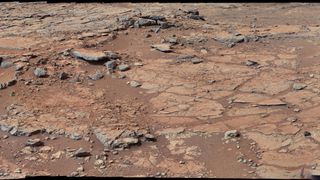Rock samples from NASA's Curiosity Mars rover contain key ingredient of life

Martian rock samples collected by NASA's Curiosity Mars rover show signs of key ingredients for life as we know it on Earth.
The venerable Curiosity Rover drilled samples from Gale crater, the site of an ancient lake on Mars. Using these samples, scientists were able, for the first time, to measure the total amount of organic carbon in Martian rocks, according to a statement from NASA.
Organic carbon, which is carbon bound to a hydrogen atom, is a prerequisite for organic molecules created and used by all known forms of life. However, organic carbon can also come from non-living sources, such as meteorites and volcanic eruptions. While previous studies have detected organic carbon in smaller quantities in Martian rock samples, the new measurements provide insight into the total amount of carbon in organic compounds.
Related: Stunning Mars photos by the Curiosity rover show ancient climate shift
"Total organic carbon is one of several measurements [or indices] that help us understand how much material is available as feedstock for prebiotic chemistry and potentially biology," Jennifer Stern, lead author of the study and a space scientist at NASA's Goddard Space Flight Center in Greenbelt, Maryland, said in the statement. "We found at least 200 to 273 parts per million of organic carbon. This is comparable to or even more than the amount found in rocks in very low-life places on Earth, such as parts of the Atacama Desert in South America, and more than has been detected in Mars meteorites."
Today, Mars is not a suitable environment for life, but there is evidence to suggest the Red Planet was more Earth-like billions of years ago, with a thicker atmosphere and liquid water on its surface — key ingredients for life as we know it on Earth.
The Martian samples were collected from 3.5-billion-year-old mudstone rocks in the Yellowknife Bay formation of Gale Crater, which Curiosity has been exploring since 2012. Scientists think that the sediment was formed through physical and chemical weathering of volcanic rocks, before settling to the bottom of the lake.
Get the Space.com Newsletter
Breaking space news, the latest updates on rocket launches, skywatching events and more!
The rover analyzed the fragments using its Sample Analysis at Mars (SAM) instrument, which uses oxygen and high heat to convert the organic carbon in the samples into carbon dioxide. From the amount of carbon dioxide produced, the instrument calculates how much organic carbon was in the original sample and tells the exact isotope ratio, which helps scientists understand the source of the carbon, according to the statement. Isotopes are forms of the same chemical element that differ in the number of neutrons in their cores.
"In this case, the isotopic composition can really only tell us what portion of the total carbon is organic carbon and what portion is mineral carbon," Stern said. "While biology cannot be completely ruled out, isotopes cannot really be used to support a biological origin for this carbon, either, because the range overlaps with igneous (volcanic) carbon and meteoritic organic material, which are most likely to be the source of this organic carbon."
However, in addition to organic carbon, the researchers identified other signs suggesting Gale crater may have once supported life, including the presence of chemical energy sources, and chemical compounds such as oxygen, nitrogen and sulfur and low acidity.
"Basically, this location would have offered a habitable environment for life, if it ever was present," Stern said in the statement.
Their findings were published Monday (June 27) in the Proceedings of the National Academy of Sciences.
Follow Samantha Mathewson @Sam_Ashley13. Follow us on Twitter @Spacedotcom and on Facebook.
Join our Space Forums to keep talking space on the latest missions, night sky and more! And if you have a news tip, correction or comment, let us know at: community@space.com.

Samantha Mathewson joined Space.com as an intern in the summer of 2016. She received a B.A. in Journalism and Environmental Science at the University of New Haven, in Connecticut. Previously, her work has been published in Nature World News. When not writing or reading about science, Samantha enjoys traveling to new places and taking photos! You can follow her on Twitter @Sam_Ashley13.
